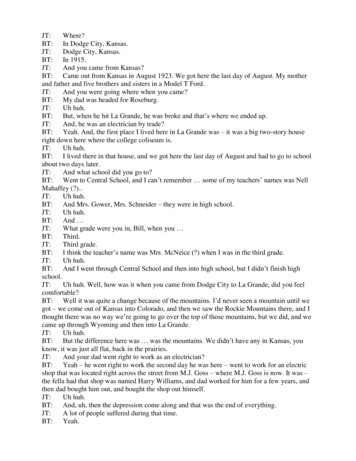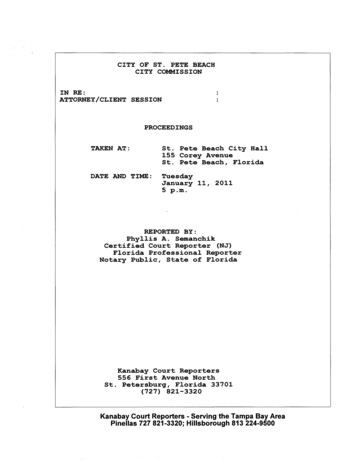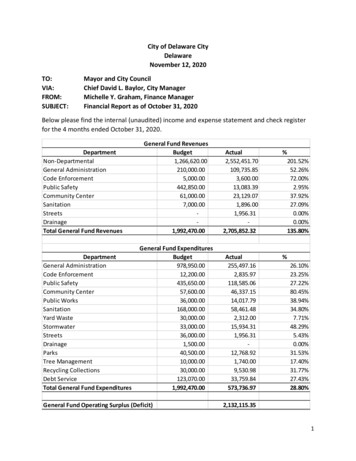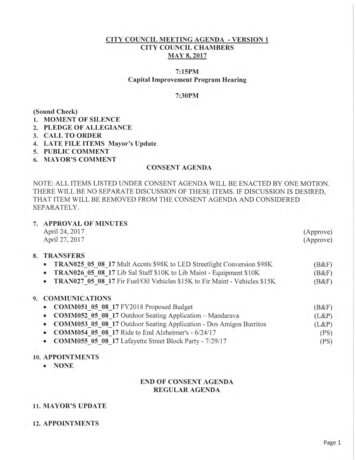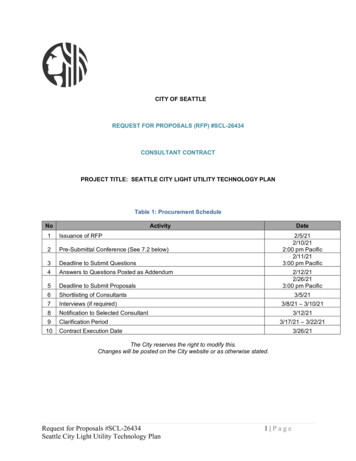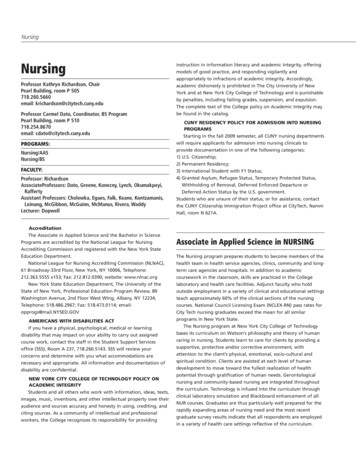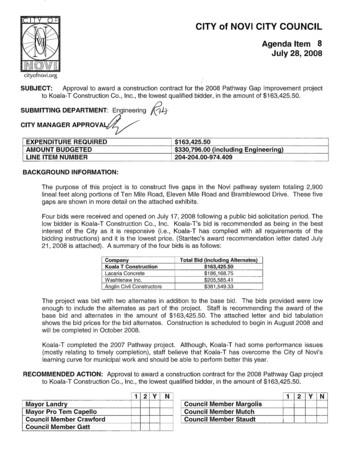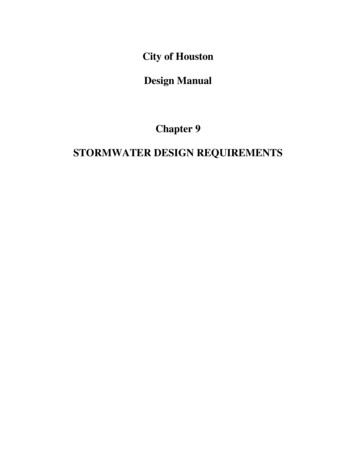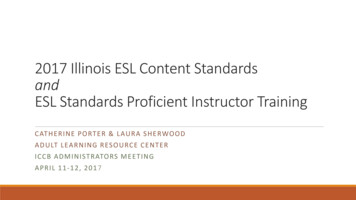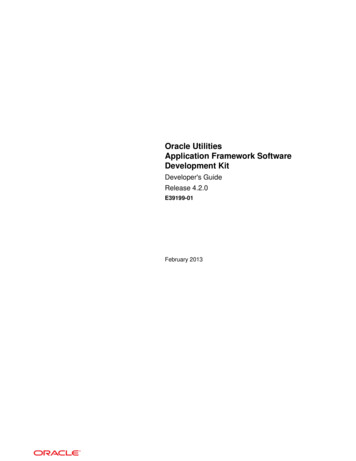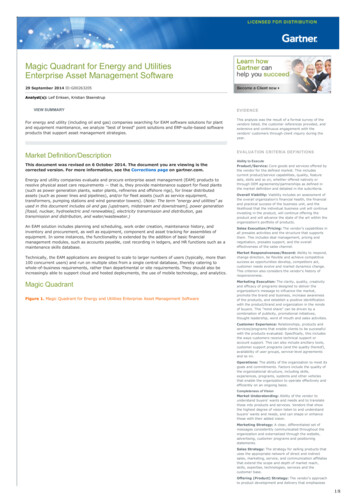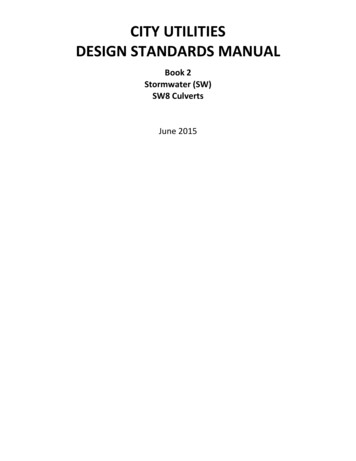
Transcription
CITY UTILITIESDESIGN STANDARDS MANUALBook 2Stormwater (SW)SW8 CulvertsJune 2015
City Utilities Design Standards ManualStormwaterBook 2 Chapter SW8CulvertsSW8.01 PurposeA culvert is defined as a conduit for the conveyance of water under aroadway, railroad or other embankment. In addition to serving hydraulicfunctions, culverts must also carry overhead loads from traffic and otheractivities, thereby serving a structural function. Proper culvert design isessential because culverts often significantly influence upstream anddownstream flood risks, floodplain management and public safety. Thecriteria presented in this Chapter shall be used in the design of culverts.A culvert as distinguished from a bridge is usually covered with embankmentand is composed of structural material around the entire perimeter althoughit can be supported on spread footings with the streambed serving as thebottom.A bridge is a structure having an opening measured along the centerline of aroadway of more than 20 feet between faces of abutments or spring lines ofarches. Multiple barrel box culverts or multiple pipe culverts having anopening of more than 20 feet between the limits of the extreme openings aresometimes classed as bridges. (Bridge Inspection Manual Definitions)SW8.02 General Design1.Federal Highway AdministrationThe design of culverts shall conform to the methodology described inthe Hydraulic Design of Highway Culverts published by the U.S.Department of Transportation’s Federal Highway AdministrationPublication No. FHWA-NHI-01-020, September 2001 (Revised May 2005or current edition) Available online ndiana Department of TransportationThe Indiana Department of Transportation Design Manual 2011 orcurrent edition provides valuable culvert design information. TheDesign Manual is available online SW8.03 Hydraulic Design1.Design ProgramThe HY-8 program is the computerized implementation of FHWA culverthydraulic approaches and protocols and shall be used for culvert design.Available online oftware/hy8/2.BackwaterCulverts shall not increase backwater elevations on upstreamproperties. Backwater shall be contained within existing banks of theupstream open channel.June 1, 20151
City Utilities Design Standards ManualStormwater3.Book 2 Chapter SW8CulvertsOverland Flow RoutesEmergency overland flow routes shall be checked to assure thatbackwater resulting from a potentially blocked culvert or intense stormdoes not flood or damage property. If an emergency overland flowroute is not available, culvert flow capacity shall be increased. Soundengineering judgment shall be applied in determining the potentialextent of backwater damage and the necessary increase in culvert flowcapacity.4.Minimum DiameterThe minimum diameter for culverts crossing a public roadway shall be15 inches (15”). The minimum diameter for private driveway culvertswithin right-of-way shall be 12 inches (12”).5.Flow VelocityBoth minimum and maximum flow velocities should be consideredwhen designing a culvert. A minimum velocity of 3.0 feet/second whenthe culvert is flowing partially full is recommended to ensure a selfcleaning condition during partial depth flow. The maximum velocityshould not exceed culvert manufacturer recommendations. Themaximum velocity should be consistent with channel stabilityrequirements at the culvert outlet. The maximum allowable outletvelocity of culverts, which discharge to an earthen channel, shall be 6feet/second. As outlet velocities increase, the need for channelstabilization at the culvert outlet increases. If velocities exceedpermissible velocities for the various types of nonstructural outlet liningmaterial available, the installation of structural energy dissipators arerequired.SW8.04 Design Storm1.Public CulvertsPublicly owned culverts crossing a roadway shall be designed to conveythe peak flow resulting from a 100-year event. Driveway culverts withinright-of-way shall convey the peak flow resulting from a 50-year event.2.Private CulvertsPrivately owned culverts located outside right-of-way and serving areaswhich do not require detention shall be designed to convey the peakflow resulting from a 50-year event and provisions shall be made tocontain the runoff from a 100-year event. Lesser capacities may beconsidered provided that proper accommodations are provided for onsite storage of the 100-year event.SW8.05 Sumped CulvertsCircular and elliptical pipes shall be installed with pipe inverts lower thanadjacent channel flowline. Sound engineering judgment shall be applied toJune 1, 20152
City Utilities Design Standards ManualStormwaterBook 2 Chapter SW8Culvertsdetermine the depth of sumping. Sumping increases the base flow capacityof circular and elliptical pipes, accommodates the future lowering of thechannel, may increase the depth of pipe cover, and in environmentallysensitive areas allows for a natural stream bottom in the pipes.SW8.06 Structural Design1.LoadingAll culverts crossing a roadway shall be designed to withstand aminimum HS-20-44 loading as defined by the American Association ofState Highway and Transportation Officials (AASHTO). Culverts crossinga railroad shall be designed to withstand an E-80 loading.2.Installation DepthRefer to manufacturer specifications or recommendations forinstallation depth requirements.Minimum pipe diameters, classes and cover requirements are listed inChapter MA5 –Stormwater Materials and Testing Requirements.3.Bedding and BackfillBackfill classifications, materials, and methods of compaction shall be inaccordance with City Utilities standards for projects inside of the Citylimits and in accordance with County Highway standards outside theCity limits unless special circumstances warrant otherwise.Bedding and Backfill standard details are located in Chapter CADD8 –Standard Drawings and Details.4.Floatation and AnchoringPipe floatation can occur when the uplift (buoyancy) forces outside thepipe are greater than the downward weight forces on the pipe. Thisuplift force can be great enough to cause the pipe to bend and dislodgefrom the embankment. Large diameter, flexible material culverts aremore vulnerable to floatation. Anchoring may be achieved usingconcrete end sections, ties to a concrete footer, or other similar means.SW8.07 Culvert Length DeterminationCulvert length design shall consider embankment width, installation depthand embankment slopes. Culvert length shall be designed to comply withChapter SW10 – Crossing.SW8.08 Inlet and Outlet ConfigurationAll culverts, public and private, shall have end treatments such asprefabricated end sections, wingwalls and aprons, or headwalls at the inletand the outlet. The design of end treatments shall consider public safety anderosion control.June 1, 20153
City Utilities Design Standards ManualStormwater1.Book 2 Chapter SW8CulvertsRoadside SafetyRoadside ditch culverts for commercial and residential drives shall havesloped prefabricated end sections. Headwalls and wingwalls are notpermitted.2.Trash RacksTrash racks should be considered for inlet culvert end treatment whereinlet clogging or downstream trash pollution is anticipated due toupstream land use activities. In general, trash racks shall not be used onculvert outlets. However, trash racks may be warranted on outlets inareas where public safety is a concern.3.Erosion ControlChannel stabilization and erosion control measures shall be utilized atthe inlet and outlet of a culvert.SW8.09 Environmental ConsiderationsIn channels with a base flow or normal pool, migration of aquatic speciesshould be considered. Culverts should be sumped to maintain a base flowdepth through the culvert equal to or greater than the adjacent channel baseflow depth. Bottomless culverts may be considered to maintain a naturalstream bottom.Where fish migration is a concern, contact the Indiana Department of NaturalResources (IDNR), Division of Fish and Wildlife for culvert design assistance.SW8. 10 PermittingCulvert installation may require approval and/or permitting from federal,state, or local agencies. Early coordination regarding permitting and approvalis recommended. Each public agency may have design criteria which must becomplied with for permitting.1.Public Agencies June 1, 2015City of Fort Wayne Street Engineering Department for work withinCity street or road right-of-way.Indiana Department of Transportation, Fort Wayne District for workwithin State, Federal, or Interstate Highway rights-of-way.Allen County Highway Department for work within County roadright-of-way.Fort Wayne Parks and Recreation Department for work affecting theRiver Greenway or trail and bicycle system.Allen County Surveyor’s Office for work affecting Allen Countyregulated drains or mutual drains.Allen County Department of Planning Services (DPS) for work withina flood zone.Indiana Department of Natural resources (IDNR) for:4
City Utilities Design Standards ManualStormwater Book 2 Chapter SW8CulvertsEarly coordination for projects affecting stream channels orwetlands.Stream crossings.Work within a floodway or flood plain.All culverts and bridges, public or private, with a drainage areaequal to or greater than 1 square mile.Indiana Department of Environmental Management (IDEM) for EarlyCoordination for projects affecting stream channels, includingregulated drains.United States Army Corps of Engineers (USACE) for EarlyCoordination for projects affecting wetlands or stream channelsincluding regulated drains.After Early Coordination is submitted to IDNR, IDEM and USACE (It isadvisable to copy affected local public agencies) a field check isscheduled. On the field check IDNR, IDEM and USACE will determinewhich agency/agencies have jurisdiction and what permitting will berequired.SW8.11Culvert MaterialsCulvert materials must be in accordance with Chapter MA5 - StormwaterMaterials and Testing Requirements.June 1, 20155
Trash Racks Trash racks should be considered for inlet culvert end treatment where inlet clogging or downstream trash pollution is anticipated due to upstream land use activities. In general, trash racks shall not be used on culvert outlets. However, trash racks may be warranted on outlets in areas where public safety is a concern. 3. Erosion Control Channel stabilization and erosion control .

